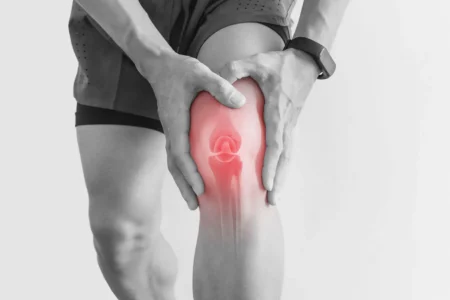Knee roughness: It means the erosion or disintegration of the cartilage that protects the bones from direct friction. It usually affects the elderly and causes severe pain and difficulty in movement.
Knee roughness factors:
old age
Obesity that puts pressure on the joint
Arthritis
Sitting for long periods in the wrong position
Some diseases such as gout and rheumatoid arthritis
Symptoms of knee roughness
knee pain
Inability to move the knee.
knee stiffness
The feeling of not being able to control the leg.
Knee roughness physical therapy
– The physiotherapist at the Egyptian Center for Physiotherapy uses hot and cold compresses to reduce swelling and inflammation of the knee, It increases the smoothness of movement.
– Using the shock wave device with advanced cases of knee roughness.
– Manual therapy and therapeutic exercises appropriate for each patient according to his condition.
Cruciate ligament injuries
The cruciate ligament’s job is to stabilize the knee.
Cruciate ligament injuries, such as tearing or spraining, usually occur when suddenly stopping. or change the direction of movement, or violent jump, They are common accidents in sports such as football and basketball.
Symptoms:
A cruciate ligament rupture or sprain is accompanied by symptoms that can be limited to:
Swelling of the affected area
A feeling of severe pain
Inability to bend and straighten the knee
treatment:
Physiotherapy sessions at the Egyptian Center for Physiotherapy help improve the condition of the knee. Through exercises to strengthen the muscles surrounding the knee, balance exercises, and some devices, and to restore movement fully and naturally.
Cartilage and knee ligament injuries
Symptoms:
Knee injuries are among the most common injuries among athletes. It has symptoms that distinguish it from other infections, such as:
Hearing sounds when bending and straightening the knee, such as cracking
The appearance of a prominent bone in the knee area
Swelling and redness of the knee
Sensation of strong pain in the knee when performing the simplest movements.
Types of knee injuries:
Bone fractures: In some sports, the bones surrounding the knee can be fractured, especially in a violent collision or fall.
knee sprain: The knee is surrounded by four ligaments that stabilize it. front, side, rear and interior, When the knee is sprained, one or more of these ligaments is torn or stretched. In this case, the injured person must rely on a skilled physiotherapist so that the injury does not lead to new complications that may impede movement.
Knee sprains are classified into three types according to their severity. Or according to the extent of the rupture to which the ligament was subjected and the resulting insufficiency in the functioning of the knee, Which:
First-degree sprain: It is the simplest type of sprain, and it results from stretching the knee ligaments without rupturing one of them. The condition is controlled to prevent ligament rupture.
Second degree sprain: It results in a partial tear in one of the tissues and a slight dislocation in the knee joint.
Third-degree sprain: It results in a complete rupture of one of the ligaments, and the knee joint then becomes unstable.
Knee stress: caused by stretching of the tendons and muscles of the knee, Which usually occurs from excessive bending and straightening of the knee, which is common in sports such as cycling, or running, This causes knee pain that limits movement.
Meniscus tear: The knee joint contains two semicircular cartilages. Each cartilage absorbs shock and facilitates the movement of bones at the joint. These cartilages can undergo acute injury within a short time. As this case is likely to be accompanied by hearing a sound in the knee indicating the occurrence of the rupture, In addition to the feeling of pain and the appearance of redness and swelling in the knee joint.
Knee dislocation: It is one of the rare cases, but it is one of the most serious knee injuries, as the damage includes the nerves and blood vessels surrounding the knee, which requires surgical intervention. Hence professional physiotherapy to save knee function.
Knee bursitis: The sac of fluid that surrounds the knee joint is known as the bursa. There are two bursa around the knee. They absorb shocks and reduce friction between joint tissues. As a result of excessive flexion and extension of the knee, inflammation of the knee bursa usually occurs. Inflammation also occurs as a result of infection.

